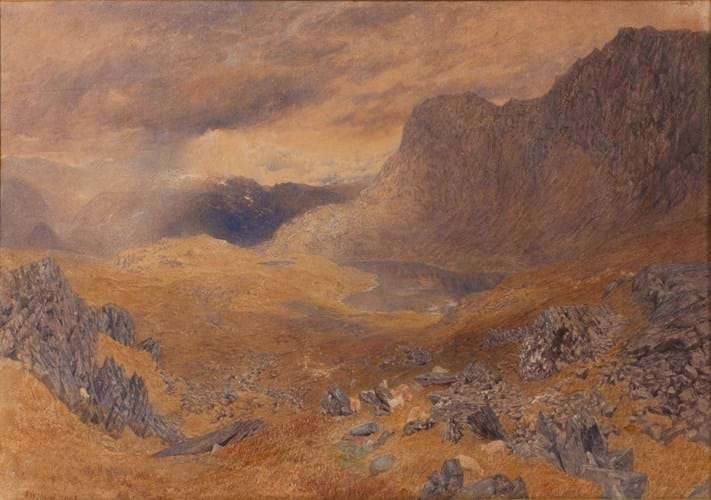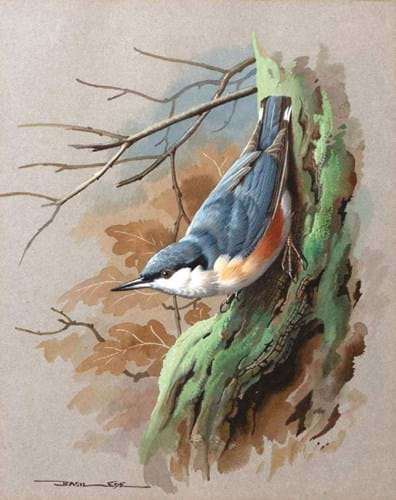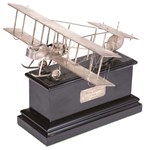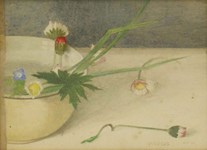An appealing subject can go a long way towards helping a picture achieve a healthy price.
This is something true even in the more challenging areas of the art market such as traditional British watercolours.
While a good subject counts for a lot when it comes to any work on paper, watercolours still need to be attractively pitched as well as preferably fresh to the market and in good condition to bring reasonable levels of demand these days.
Lake District appeal
A landscape by Alfred William Hunt (1830-96) that came up at Mallams (25% buyer’s premium) in Oxford on October 19 was among a number of watercolours bringing decent competition.
Key to the interest that emerged was the fact that it depicted a wellknown Lake District location which lifted it well above the more standard fare. It also benefited from being offered with a highly obtainable estimate.
The 10¼ x 14¾in (26 x 38cm) watercolour was a study of the Langdale Pikes. The compact series of peaks within Great Langdale are among the most recognisable mountains in the area and a dramatic setting for an adventurous hike.
This meant that the watercolour had a strong appeal to today’s collectors who focus on views of the Lakes – some of whom are well heeled and will make strong bids when the ‘right’ works appear.
The picture at Mallams was also desirable for a few other reasons, not least a series of artistic factors.
Hunt’s working methods were almost scientific in approach as he made numerous detailed studies in preparation (this is one reason his overall output was not as great as other watercolourists of the age). The example in Oxford, which was carefully executed, demonstrated this attention to detail.
The sweeping landscape under a powerful sky was elegantly executed but Hunt also used a highly finished technique to portray the rocks and other landscape features. It therefore showed the two key influences on the artist – the atmospheric paintings of JMW Turner and the precise outlines adopted by the Pre-Raphaelites. In short, it showed the kind of technical qualities that won him the praise of Ruskin no less.
The picture was signed and dated 1857, making it earlier than many of Hunt’s works on paper – it was only in 1861 after he got married and moved to Durham that he devoted himself fully to the watercolour medium. Hunt’s watercolours appear fairly often on the market and most are relatively affordable, selling for about £1000 or less. This probably explains the £400-600 estimate placed on this picture here, although the fact that it came with a few condition issues may also have been a factor.
Although it had not been examined out of the frame, the colours had faded a little and some browning was noticeable to the sky in particular. Nevertheless, the combination of a striking composition with a known and highly identifiable Lake District location meant that the watercolour captured the imagination of bidders, especially against a tempting estimate.
After a good contest, it was eventually knocked down at £8200 to a UK trade bidder who was participating online. In terms of the current market, the price looked pretty strong. While two decades ago when the market was stronger the most desirable Hunt watercolours could make well over £10,000, this was the second-highest price for the artist in the last five years according to Artprice.
Farmyard flourish
Another watercolour bringing competition at Mallams was a Stanley Anderson (1884-1966) farmyard landscape.
The Bristol-born artist is best known for his printed work – his father was a silver engraver and, after studying at the Royal College of Art, Anderson later became an engraving tutor at Goldsmith’s College.
For both his printed and painted work, rustic scenes were his preferred subjects and the 10½ x 9¾in (27 x 25cm) signed watercolour in Oxford was a vintage example.
His watercolours appear less often on the market than his engravings and this one, which was in good condition with fresh colours, was deemed a good proposition against a £700-900 estimate.
It duly sold at £1900 to a private collector, a sum that was not only above average for such a work but in fact stands in the top five prices for Anderson at auction (source: Artprice).
Bird studies
An active sub-sector of the watercolours market, ornithological studies, was represented at the Mallams sale by three works by Basil Ede (1931-2016).
A founder member of the Society of Wildlife Artists, Ede had his first solo show at the Rowland Ward Gallery in London in 1958 and became the first living artist to have a major exhibition at the Smithsonian Institution in Washington, DC, in 1964.
Large and colourful paintings of pheasants and mallards by the artist have sold for over £5000 at auction before but the three works offered here were watercolours depicting smaller domestic birds. All three sold well above their tempting estimates, going to two different buyers.
The highest price of the group came for a 9¾ x 8in (25 x 20cm) signed watercolour and body-colour of a nuthatch. The most colourful of the trio, it easily flew over a £200- 300 estimate and was knocked down at £1900 to an online buyer.
The other two pictures depicted a lesser spotted woodpecker that sold at £850 against the same estimate and a lapwing that fetched £1000 against a £150-250 pitch.
These were all decent sums for Ede watercolours on this scale.

















